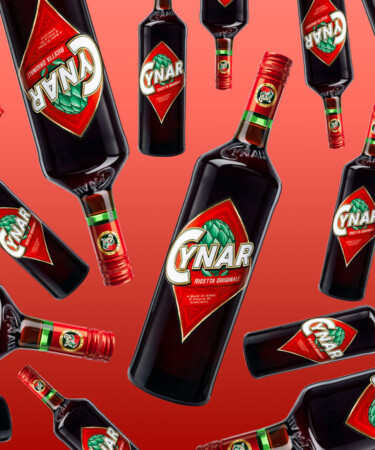Among rows of classic Italian amaro bottles at bars or shops, Cynar always manages to stand out. The beloved bitter liqueur proudly displays its unique main ingredient front-and-center on its playful packaging: the earthy, herbaceous artichoke.
While the pointy green vegetable might seem like a peculiar ingredient to highlight, Cynar celebrates all that the artichoke has to offer, including its complex vegetal flavors and a delightful bitterness. But let’s be clear: This isn’t artichoke juice. The beverage is made with a combination of several herbs and spices that deliver a layered and intense amaro — one that’s inspired a cult-like following among bartenders.
Even though Cynar has been popular since its debut in the 1950s, the drink really took off stateside over the past two decades during America’s cocktail renaissance, as bartenders used it to add more bitter complexity to classics and new concoctions. In addition to being a great cocktail ingredient, Cynar can be enjoyed as an aperitivo in a spritz or poured neat as an after-dinner drink. Either way, this versatile beverage belongs on your bar cart.
Since you’ll be seeing this artichoke-clad bottle around a lot, you should probably brush up on some fun facts. Here are nine things you should know about Cynar.
-
Cynar is relatively young for an amaro brand.
Even though the brand has over 70 years of history, Cynar is still the new kid on the block when it comes to classic Italian amari. Other big companies in this category, like Fernet-Branca and Montenegro, date back to the 1800s and have been made by generations of experienced distillers. Cynar, though, was only created in 1952 by Angelo Dalle Molle, a Venetian entrepreneur and philanthropist. He had been toying around with the idea of incorporating the artichoke’s potent nutritional — and potentially aphrodisiac — qualities into an amaro. Once he found the perfect formulation, he brought it to market where it took off as the cool newcomer.
-
The recipe is a secret.
While Cynar’s iconic label most prominently features its signature artichoke, there’s more to this amaro than meets the eye. The website says there are 13 different plant and herbal components that go into this liqueur’s signature profile, but artichoke is the only ingredient the brand is willing to disclose. The full recipe — which hasn’t been tinkered with since the brand launched — has been a well-guarded secret since the drink’s conception.
-
The root of Cynar’s name comes from the Latin word for ash.
Cynar takes its name from the botanical name for artichoke: Cynara cardunculus. This term stems from “cinus,” which is the Latin word for ash. Ashes and artichokes might seem like an odd connection to make, but ashes were used to fertilize the plant in ancient times, so they eventually became closely tied.
-
The Cynar name is also related to Greek mythology.
The roots of Cynar’s name also extend into Greek history. According to one tale, Zeus once fell madly in love with a beautiful girl with ash-colored hair named Cynara, who was basking in the sun on the island of Kynaros. Intrigued by the girl, Zeus transformed her into a goddess and brought her up to Mount Olympus. Eventually, Cynara grew weary of being Zeus’s mistress and returned to the island without permission, which enraged the god. In a fit of fury, he conjured leathery scales that consumed her body and left only a scorned heart in the middle — and this became the story of the first artichoke.
-
The brand had a very successful first marketing campaign featuring a famous Italian actor.
The brand still attributes much of its early success to its first ads: a series of TV commercials starring Italian actor Ernesto Calindri. These premiered on the Italian “Carosello,” an advertising broadcast show that aired from 1957 to 1977. The program was an experiment to see if longer advertisements that were more seamlessly integrated into the viewing experience could capture the attention of audiences. Cynar’s long, comedic ads featuring a top actor gave the brand the momentum it needed to blow up in its home country.
-
Cynar’s chemical properties might trick your tongue.
The active ingredient in artichokes, appropriately called cynarin, has a strange effect on your taste buds. Cynarin actually inhibits your sweet-perceiving taste buds, which is likely why artichokes can be considered as harshly bitter and vegetal. But when you take your next sip or bite, it washes away the cynarin, suddenly causnig the sweet taste receptors to be more sensitive and your next bite to taste disproportionately sweet. Cynar may be able to attribute some of its complex bittersweetness to this phenomenon.
-
There’s a boozier Cynar option, too.
The flagship bottle of Cynar comes in at 16.5 percent alcohol, which makes it wonderfully versatile to use as an aperitivo or a cocktail component. But for those looking for more intensity in both bitterness and booze, the company launched Cynar 70 in 2015, which offers double the alcohol of the original 35 proof version. This bottle has bolder flavors and is geared toward being enjoyed chilled after dinner as a digestivo.
-
Cynar is the perfect sub for other popular amari in cocktails.
Due to its intense herbal flavors, Cynar can be an acquired taste, so those new to the amaro can start off by incorporating it into some familiar classics. It can be a great replacement for Campari to make a more bitter Negroni, or can replace Aperol in a spritz for an herbaceous twist. You can find more ways to incorporate Cynar into cocktails here.
-
Cynar is popular in handshake shots.
Since it took off as an industry favorite, shots of Cynar are often exchanged between bartenders as a welcome or acknowledgement of an industry peer. While this drink could be straight Cynar, many pros are getting more creative with their handshake shots these days. One popular example is the Choke and Smoke, made with a mix of Cynar and mezcal.
